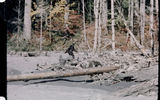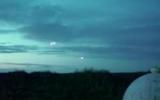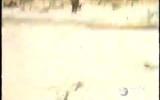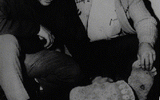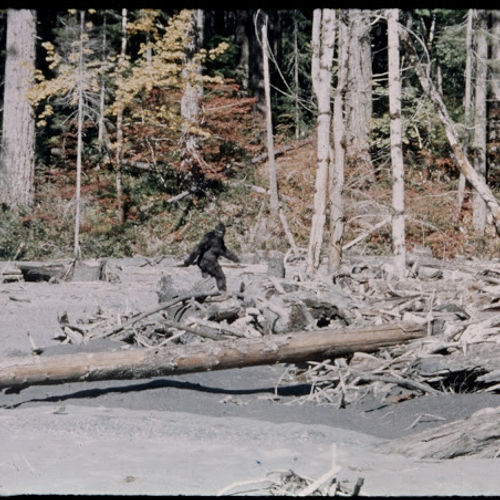
| Added | Sat, 10/02/2018 |
| Источники | |
| Феномены |
Stories of Bigfoot were found in the myths of the Indians, and evidence of meetings with the hairy, muscular, bipedal APE-like creatures about 3 meters (6-9 feet tall) appeared in the eyewitness accounts and newspaper publications since the nineteenth century. However, one of the first convincing evidence of the existence of Bigfoot is the Patterson film I believe-Gimlin (Patterson–Gimlin film), also known as the Patterson film (the Patterson film) or PGF. This short entry documenting an unknown humanoid creature, was made on 20 October 1967 (some critics believe that it was removed previously) in Northern California. Its authors were Roger Patterson (Roger Patterson) (14 February 1933 - 15 January 1972) and Bob Gimlin (Robert "'Bob" Gimlin) (born October 18, 1931).
The footage was taken near the Bay bluff Creek (Bluff Creek) tributary of the Klamath (Klamath River), approximately 25 km North-West from Orleans (California), in Humboldt County (Humboldt County).
The film has a length of 23.85 ft (726,948 cm), contains 954 frame; recording time is 59.5 seconds at 16 frames per second.
Patterson became interested in the subject of Bigfoot after reading an article by Ivan T. Sanderson (Ivan T. Sanderson) in the magazine "Truth" ("True") in December 1959. Two years later (in 1961) Sanderson published a book about this phenomenon called "Abominable Snowwomen: Legend Come to Life", and then (in 1966) the following – "Do Abominable Snowmen of America Really Exist?". Reading this literature prompted Patterson to search for Bigfoot by yourself accompanied by friend Bob Gimlin.
It is believed that a certain ray Wallace (Ray Wallace) told the Paterson, where you can see Bigfoot. According to another report, Patterson was interested in the recent reports of a strange hairy man and finds a huge footprint in the area of the National reserve "Six rivers" (Six Rivers National Forest). The area was familiar to him, so we decided to go there.
20 October 1967, they moved on horseback upstream along the Eastern shore of the Bay bluff when between 13:15 and 13:40 almost simultaneously noticed a huge hairy creature among the trees. Patterson grabbed the camera and shot video until the creature disappeared from sight. After that, they went to their camp three miles (4.8 km) to the South, took the plaster back, measured step of the creature and made two cast of track (left and right feet).
Friends is back in town and tried to equip the team in search of the creature. Four people from the U.S. forest service confirmed that the 19 (or 20) numbers they have not seen this place no traces, however, having arrived there on 23 October, they found footprints and made six pictures with a set of footprints as evidence. Taxidermist Robert Titmus visited this place with my sister and brother-in-law nine days after the event. He was able to make a few more casts and to map the trajectory of the creatures.
The film was replicated for study and display in various programs. At the moment, the whereabouts of original unknown. In scientific circles, the film was not taken seriously, and only a few scientists agreed to look at it.
The analysis of the original film showed that the shooting genuine, without the use of installation. But with regards to its content, scientists ' opinions were divided.
For what the film really hit the unknown creature spoke:
- Dimitri Bayanov, Igor Bourtsev, and Rene Dahinden (they expressed their thoughts in the work "analysis of the Patterson film-Gimlin why we find it authentic");
- Dmitry Donskoy, head of the Department of biomechanics at the Central Institute of physical culture of the USSR, who led the research film in cooperation with Moscow Darwin Museum and is also expressed in favor of that depicted a creature yet unknown to science;
- Expert in animation and computer effects Ruben Steindorf of Vision Realm (Reuben Steindorf), created based on the creatures from the movie a computer model that, in his opinion, did not meet the man in the suit;
- Gordon Property, expressed their arguments in "The Crested Australopithecus Robustus and the Patterson–Gimlin Film";
- Medical examiner Jeff Glickman (Jeff Glickman), who also published an article with their opinion;
- Anthropologist Grover Krantz (Grover Krantz), who is initially skeptical of the Patterson film, by analyzing only the pictures published in the magazine Argosy Magazine, but changed his mind in 1969, after watching the movie;
- Jeffrey Meldrum (Jeffrey Meldrum) from the University of Idaho, who believes that intermembrane index (IM), i.e. the ratio of the lengths of the front and hind limbs, the creatures from the movie are not typical for a man or large monkey.
But there were those who held the opposite view and considered the film a fake:
- Zoologist Bernard Heuvelmans (Bernard Heuvelmans) believed that the appearance of the being does not correspond to the primates, and the behavior is not typical for wild creatures;
- Anatomist D. V. Grayv (DW Grieve) from Royal Free Hospital School of Medicine also reviewed the record and came to the conclusion that if it's a fake, it is very artfully done; in his opinion, it could be fast walking people in slow-motion;
- a renowned expert on primates by John Napier (John Napier) is one of the few academics, who acknowledged the possibility of the existence of Bigfoot, and felt that the Patterson film is a fake; in particular, he argued that the size of the traces is completely contrary to the estimated height of the creature;
- Esteban Sarmiento (Sarmiento Esteban), a specialist in physical anthropology at the American Museum of natural history, also mentioned the non appearance of the creature and his behavior; he believed that the ratio of the limbs, the growth and behavior of the creatures are more characteristic of man than a wild beast: "the Ratio of the body is within the human range and differs markedly from any living APE and the scientists found fossils (index IM is in normal human range)";
- David J. Darling (David J. Daegling) and Daniel O. Schmitt (Daniel O. Schmitt) from the University of Florida studied the film and came to the conclusion that it is impossible to definitively determine whether the creature is "not human", but noted that the characteristics of the gait of the creature can easily reproduce.
- Jessica rose (Jessica Rose) and James gamble (James Gamble) from the laboratory of movement analysis and gait at Stanford University conducted an analysis of the gait of the creature on film; the results were shown in one of the episodes of the series "Best evidence" ("Bigfoot". Best Evidence. Episode 2. Discovery Channel)
- Cliff crook (Cliff Crook) and Chris Murphy (Chris Murphy) were staunch supporters of the authenticity of the video, however, the detailed analysis of film found in the creature a likeness of the zipper (probably the original material is very different from that which can be found on the Internet, because the available copies are difficult to allocate a closure with such a grain); they wrote in conclusion: "Despite the fact that the Patterson film is a hoax, it does not mean that Bigfoot does not exist."
In 2002, after the death of ray Wallace, an opinion appeared that the whole story with the Yeti was rigged: "Yeti footprints" were made of wooden forms, and the film hit the staged episode with a man in a specially tailored suit.
So, 3 Jan 2003 on the front page of The New York Times published an article that talked about deathbed confession of ray Wallace, who allegedly participated in the filming of the famous Patterson film. In some publications it was argued that the suit was him, some with his wife. However, many researchers believe information about this recognition lies. They indicate that the confession was made the person who made the famous picture of Nessie, and Bigfoot is not. However, they do not deny that Wallace could fake footprints.
It seems that none of the supporters or opponents of the authenticity of being on the record was not able to convince others of the correctness. Usually all disputes end with the opinion that the quality of the frame is too bad to be able to make a final decision based on the content of the film.
Translated by «Yandex.Translator»
Log in or register to post comments

